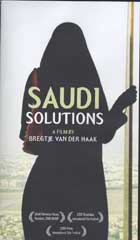
Saudi Solutions 2006
Distributed by First Run/Icarus Films, 32 Court St., 21st Floor, Brooklyn, NY 11201; 800-876-1710
Produced by VPRO Backlight
Directed by Bregtje van der Haak
VHS, color, 77 min.
Sr. High - Adult
Middle Eastern Studies, Multicultural Studies, Sociology, Women's Studies
Date Entered: 07/26/2007
Reviewed by Sandy River, Architecture and Humanities Librarian, Texas Tech UniversityFilmmaker Bregtje van der Haak went to Saudi Arabia to find out how working women in Saudi Arabia view themselves and how they live in accordance with the Koran in the 21st century. It didn’t take her long to learn how difficult the project would be. Mistrustful of Western media and ever-mindful of the restrictions imposed by Saudi interpretations of Islam, few women were willing to appear on camera. She managed to find a part-time journalist, a gynecologist, a photographer, a newsreader, and Saudi Arabia’s first female airplane pilot—very different women sharing a role in modernizing their country.
In addition to fairly open conversations with the women, the film takes us into the home of one and the places of work of others. We get a better feel for what it is like to live in a country so shaped by fundamentalist Islam. The journalist acknowledges that it would be more convenient if she could drive. The doctor explains that more women would go to medical school, but families fear that educated women will not marry or won’t devote themselves to having the norm of five children. The photographer is glad to know that there are a few hours during the week when women can take care of their own business affairs at some offices rather than having to have a man serve as intermediary. But none of these women shows any exasperation with Islam or Saudi society. They seem hopeful about change taking place but do not seem impatient.
In addition to the women, the film introduces us to Prince Alwaleed Bin Talal, the fifth richest man in the world and surely something of a maverick in the royal family. He has made it his mission to incorporate women into the economy of Saudi Arabia, having noted the large number of foreign workers in a country where only 5% of women work. In his company fifty percent of the employees are women, and they wear stylish Western clothing without veils. Yet even in this progressive atmosphere, men and women work and pray separately, following the dictates of Islam. There are other signs of changing attitudes. The doctor’s husband is quite insistent that girls must be educated. And one of the women reports that educated women are preferred as brides because they can contribute needed income in an increasingly expensive society.
Watching this film, you want to know how much of their conformity to societal rules about women’s place derives from religious devotion and how much from fear of the religious police. The Commission for the Promotion of Virtue and Prevention of Vice—the religious police—lurks in the background throughout the film. It is the filmmaker who brings them up, and both the women interviewed and Prince respond matter-of-factly about complying with the precepts of Islam. But the viewer almost feels complicit, as though in watching these capable women, you are doing something wrong – breaking some rule.
Saudi Solutions is excellent as a spark for discussion of cultural differences and of our Western biases and stereotypes. These covered women are not backward. The attractive, well-dressed women working for the Prince are not a harem. We expect these women to feel oppressed: are they really so accepting of the restrictions placed on them, or are they just very careful not to draw attention to themselves? And how much can a society modernize when fundamentalist religion pervades everything?
The film is well edited and of good technical quality.